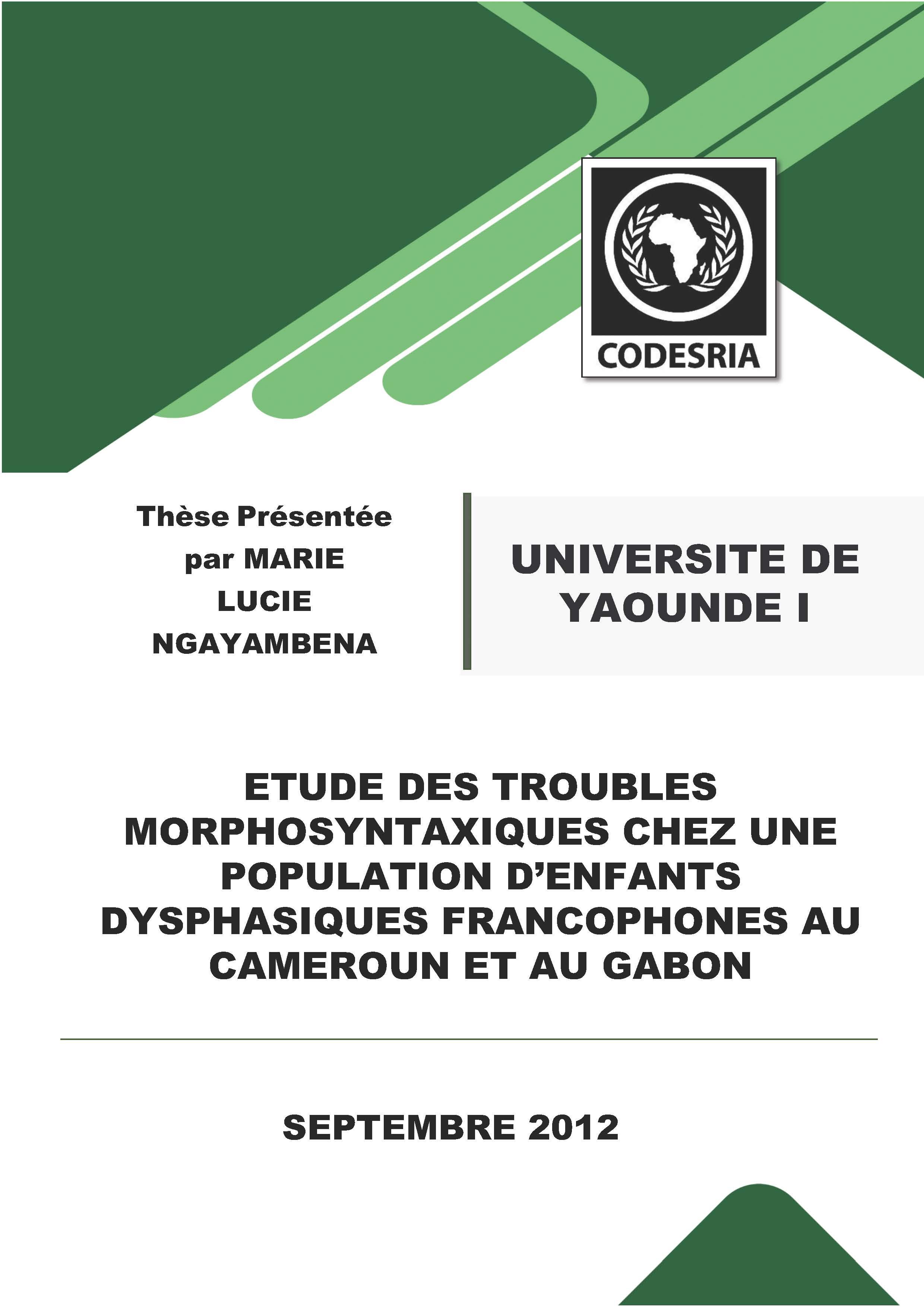ETUDE DES TROUBLES MORPHOSYNTAXIQUES CHEZ UNE POPULATION D’ENFANTS DYSPHASIQUES FRANCOPHONES AU CAMEROUN ET AU GABON
Keywords:
TROUBLES MORPHOSYNTAXIQUES, POPULATION, ENFANTS, CAMEROUN, GABONSynopsis
In order to enable the fulfillment and the school and social insertion of the child, a study is carried out a research on the topic: « A study of morphosyntaxic disorders in French speaking children in Cameroon and Gabon. » The present study is divided into two parts: The theoretical framework and the experimental framework. Dysphasia can be defined as a specific developing oral disorder in a child in the absence of any physiologic and anatomic cause appearing at the level of the required organs in the perception and production of the speech. By analysing the productions of dysphasic children, we notice that the morphosyntaxe aspect is the most altered. That’s the reason why this thesis focuses on the description of morphosyntaxic abilities of twelve children following a therapeutic care plan at “Fondation Horizons Nouveaux” at Libreville and at “Cabinet Orthophonique de Tsinga” in Yaoundé.
To efficiently carry out this research, the twelve children are divided into four groups. [4.3 years - 4.9 years], [4.9 years - 5.3 years], [5.3 years - 5.9 years], [5.9 years - 6.3 years]. The gap among the different groups is six months. The research instrument is the EVALO 2-6 Battery of Coquet, Ferrand and Roustit (2009). The research is conducted by using a semi-guided observation through observation charts and tasks evaluating the morphosyntaxic area. Children are tested on “Pragmatic task”, “morphosyntaxic comprehension”, “morphosyntaxic planning” and “Repeating sentences”. The results are handled in 3 phases. The first phase sums up the marks obtained in each area per child. The second phase calculates the average in “Ecart-type” per group. The last phase consists in writing the average in the synthesis – radar in order to visualise the profiles. The analysis of the results enables to determine whether children have reached the threshold of the pathology which is generally admitted as from – 2 Ecart – type. The scores of the children in the different groups situate them in the zone of low inferior and critical marks. The risk of dysphasia is great. Red scores at the repeating sentences subject shows that children have enormous disorders of syntaxic encoding. They are unable to use verbs ending and words which are characterized by a dyssyntaxy or an agrammatism. The hypothesis of a verbal comprehension disorder is possible because children present an alteration of comprehension abilities, of mental representation.
After the analysis of the results, several types of dysphasia are distinguished: expressive dysphasia, close to Wernickes’s aphasias characterized by difficulties in repeating sentences which increase the length of words, an agrammatism (the speech is often telegraphic). Comprehension is better than expression and the child is motivated to communicate. Receptive dysphasia, close to the Broca aphasias, characterized by an immature syntax, but not senseless, and the difficulties are observed more at the level of discourse organization than at simple clausal structuring. And finally, mixed dysphasia, the most frequent, are combining the first two dysphasia.
This study shows that dysphasia is still unknown in Cameroon and Gabon. To cure dysphasia in both countries, the care plan remains approximative because of the lack of hosting structures, qualified personnel, appropriate material as well as the high costs of therapy sessions. At home, parents’ contribution is of great importance and requires a good intellectual level to
apply some principles. Unfortunately, parents are unable to accompany their children in this long trial for two main reasons: incompetence and impatience. Finally, children are abandoned to the language therapist and results cannot follow immediately. This thesis enables to efficiently lay emphasis on language impairment which negative effects on normal development and fulfillment of the child constitute an important phenomenon deserving a scientific research. This study will help find methods of testing, diagnosing and the therapy care plan of african french speaking children in school area.
Downloads
References
JAKUBOWICZ, C., L. NASH, C. RIGAUT & C. L. GERARD, 1998, “Determiners and clitic pronouns in French-speaking children with SLI”, in Language Acquisition, n°7 (2-4), pp. 113-160.
JAKUBOWICZ, C., 2003, « Hypothèses psycholinguistiques sur la nature du déficit dysphasique », in C. Gérard & V. Brun (Eds.), Les dysphasies, Paris, Masson, pp.1-70.
JAMIESON, D. G., 2007, « Le développement du langage chez les jeunes enfants », in Bulletin du Conseil Canadien sur l’Apprentissage, Vol. 2, n°1, pp. 1-10.
KARMILOFF-SMITH, A., 1998, “Development itself is the key to understanding developmental disorders”, in Cognitive Sciences, 2, n°10, pp. 389-398.
KENT, R. D., 1992, “The biology of phonological development”, in C. A. Fergusson, L. Menn & C. Stoel-Gammon (Eds), Phonological development: Models, Research, Implications, Parkton, MD, York Press, pp. 35-47.
KIPARSKY, P. & L. MENN, 1977, “On the acquisition of phonology”, in J. McNamara, (Ed.) Language Learning and Though, New York, Academic Press.
KLEES, M., 1994, « Apprendre à lire sans pouvoir parler dans les dysphasies sévères », in ANAE, n°30, pp. 239-244.
KREMER, J.M. & E. LEDERLE, 2000, L’orthophonie en France, 3ème Edition, Paris, PUF, (Que sais-je, le point sur les connaissances actuelles).
KUPISCH, T., 2008, “Dominance, mixing and cross-linguistic influence: On their relation in bilingual development”, in P. Guijarro-Fuentes, P. Larranaga & J. Clibbens (Eds), First Language Acquisition of Morphology and Syntax: Perspectives across Languages and Learners, Amsterdam, John Benjamins, pp. 209-234.
LASSERRE, J. P., 2006, Les Dys, Paris, Isbergues, Ortho Edition.
LE NORMAND, M. T., 1999, « Retards de langage et dysphasie », in J. A. Rondal, et X. Séron (eds) Troubles du langage : Bases théoriques, diagnostic et rééducation, Bruxelles, Mardaga, pp. 727-748.






